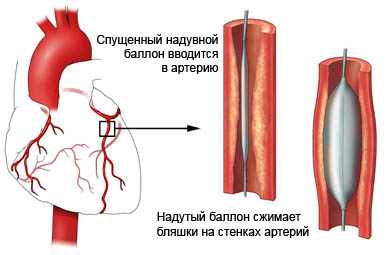Koronarnaя angioplasty – Ballonnaя angioplasty
Description coronary angioplasty
Ballonnaя angioplasty – the procedure to expand the blood vessels using an inflated balloon, administered via catheter.

Causes execution coronary angioplasty
Atherosclerosis is a disease of the arteries, in which cholesterol and fatty deposits build up on their walls. This can restrict blood flow. If the growth of plaques occurs in the heart, this can lead to a heart attack. For the treatment of atherosclerosis can be used medication and changes in lifestyle. If these measures are not enough, Angioplasty can be done.
Possible complications when performing coronary angioplasty
Prered order, how to perform angioplasty, you need to know about possible complications, which may include:
- Bleeding at the site of catheter insertion;
- Damage to the artery walls, which leads to the need for additional surgical procedures, or;
- Heart attack or arrhythmia (irregular heartbeat);
- Allergic reaction to x-ray dye;
- The formation of a blood clot (thrombus);
- Infection.
Some factors, that may increase the risk of complications include:
- Allergies to medications or x-ray dye;
- Obesity;
- Smoking;
- Coagulation failure;
- Age: 60 and older;
- Recent pneumonia;
- Recent heart attack;
- Diabetes;
- Kidney disease.
How is coronary angioplasty?
Before the procedure
Before coronary angioplasty can be performed following analyzes:
- Blood tests, especially, If the patient is taking certain medications (Tablets of high blood pressure, blood thinners, heart medicines);
- Electrocardiogram (ECG) – test, which records the heart rate by measuring the electric current, passing through the heart muscle;
- Chest X-ray.
A few days before the procedure:
- It may be necessary to stop taking some medicines:
- Anti-inflammatory drugs (eg, Ibuprofen) – for a week prior to surgery;
- Blood-thinning drugs, such as warfarin;
- Metformin or glibenclamide and metformin;
- The patient should take aspirin before and after the procedure. The doctor may also prescribe clopidogrel (Plaviks) before the procedure;
- In the evening, the day before the operation you need to take only a light meal. On the day of surgery can not eat anything;
- It is necessary to prepare for the return home from the hospital after surgery.
Anesthesia
During the operation using local anesthesia. Anesthetic is injected to the catheter (in the groin or arm). In addition, intravenous sedative to relax and to avoid discomfort.
Procedure coronary angioplasty
Groin or arm, where the catheter will be inserted will be shaved, Purified, and immobilized. The needle is inserted into an artery, on which drugs are administered. Next, the needle is introduced through a special wire, called a catheter guide. The wire is introduced, until it reaches the blocked artery in the heart. Soft, flexible tube of the catheter is fed through the wire to the desired location.
Doctor makes x-ray pictures during the procedure, to know, where the wire and catheter. Radiopaque dye is injected into the arteries of the heart. This allows you to see the vessels on the screen.
Once the area is reached lock, inflated a small balloon, located in the tip of the catheter. He opens the blocked artery. Thereafter, the balloon, catheter, and the conductor removed.
The doctor may also insert a small tube of mesh, called a stent, into an artery, where it has been narrowing. The stent keeps the artery open, preventing it from re-narrowing.
After the procedure is stopped administering drugs, blood thinners, and within 20-40 minutes of the injection site is pressed to stop the bleeding.
Then in the groin or arm bandage applied.
How long does the surgery?
The operation takes about thirty minutes to three hours.
Will it hurt?
Anesthesia will prevent pain during the procedure. The catheter insertion site may feel a slight burning. Also during the catheter may sense pressure in the vessels. In some patients administration of radiopaque dye can cause nausea and dizziness. While inflating the balloon may feel chest pain.
The time spent in hospital
If there are no complications, Out of the hospital made the next day after surgery.
Postoperative care after coronary angioplasty
In the hospital
After surgery, you need to lie down for a while in a horizontal position. To stop bleeding at the site of catheter bandage or set a special device. This will speed up hospital discharge. It is also important to follow the instructions of doctors and nurses.
At home
- Patients may be prescribed blood-thinning drugs:
- Aspirin;
- Warfarin;
- Clopidogrel;
- Prasugrel;
- Ice can help reduce the discomfort at the site of catheter insertion. It is possible to apply ice 15-20 minutes every hour, during the first few days after surgery;
- To reduce the risk of further complications of heart disease, It advised to make lifestyle changes, which includes receiving a health food, regular exercise, avoid stress;
- We need to ask the doctor about, when it is safe to shower, bathe, or to expose the surgical site to water.
Sometimes the procedure is not successful or the artery narrows again. You can repeat angioplasty or perform coronary artery bypass grafting (AKS).
It is necessary to go to the hospital in cases
- There are signs of infection, including fever and chills;
- Redness, edema, strong pain, bleeding, or discharge from the catheter site;
- Pain in the arm or leg, blue, feeling cold, numbness, pricking, swelling, or bruising;
- Nausea and / or vomiting;
- Inability to relieve pain using painkillers;
- Cough, shortness of breath or chest pain;
- Joint pain, fatigue, constraint, rash or other unpleasant symptoms.
